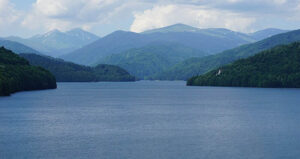France: Huge dam removal started to give room to Sélune river
-
 Editorial Team
Editorial Team
Share article:
Dam removal started to give room to Sélune river. A crane makes the first breach in the 35 metre high Vezins dam in the Sélune river in Normandy on the 12th of June. The dam will be removed to give room to the Sélune river so fish will be able to swim through the bay of Mont-Saint Michel to the sea again. This project is necessary to comply to the rules of the European Framework Directive.
Over the next two years two dams will be removed in the Sélune to open up 90 km of river. The objective is improving water quality and allowing migratory salmon to return to their ancient spawning grounds. Although environmentalists are enthusiastic, not everyone agrees with the removal of the dams. Protestants are against the removal because the dams creates a lake of 20.000 m3 of fresh water and is used to produce annually 90.000 Volts of electricity .
Good ecological status
According to the Water Framework Directive (WFD), each of Europe’s rivers must attain a ‘good’ ecological status. The latest study of the European Environment Agency shows still 40% of all European rivers fall short. Removal of old, obsolete dams is a viable option to help reach WFD goals, reconnect and restore rivers and allow fish populations and other wildlife to return and flourish.
More research needed
According to an article in Nature over 5.000 barriers have been already removed across Europe. Last year the demolition of the Yecla de Yeltes Dam in western Spain was the biggest dam-removal project in the European Union so far. Although dam removal is generally welcomed by most scientists, some call for more research into potential ill effects.
Negative side effects
Decommissioning existing river barriers might mobilize toxic sediment, or affect buildings or bridges downstream. And existing dams could help prevent the spread of invasive species such as the North American signal crayfish (Pacifastacus leniusculu) or the Asian topmouth gudgeon (Pseudorasbora parva). There are also historic dams, such as the Roman-built, 22-metre-high Prosperina Dam near Mérida in Spain, which need to be preserved as cultural heritage.

















